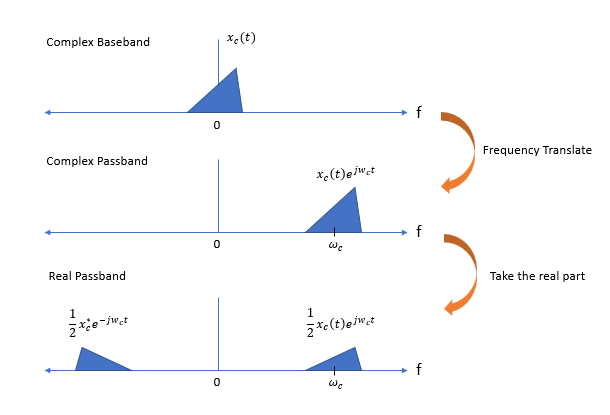I was following this interesting post by a new user Rubem Pacelli and got stuck at Proakis' referenced definition (see Section 4-1-4 starting on page 159 here). The math, all repeated further below, makes sense to me but my intuition doesn't and was hoping to better connect the two. It is likely a deeper detail I am missing with Stochastic Processes and my related assumptions. I provide my intuition first below, which completely makes sense to me, and then below that Proakis' derivation which then turns my world upside down. My question is what is the disconnect in my thought process? (I highly doubt Proakis is wrong since this is the 4th edition, and also agree with all the math he has given).
My intuition (with some math):
The real and imaginary components of a complex baseband signal are preserved in the equivalent real passband signal centered about a carrier frequency according to:
$$ x(t) = x_i(t) \cos(\omega_c t) - x_q(t) \sin(\omega_c t) \label{1}\tag{1}$$
and
$$ x_c(t) = x_i(t) + j x_q(t)\label{2}\tag{2}$$
Where:
$x(t)$: (real) passband signal
$x_c(t)$: (complex) baseband signal
$\omega_c$: (real) the carrier frequency as $2\pi f_c$ where $f_c$ is in Hz.
$x_i(t)$: (real) the real component of the complex baseband signal
$x_q(t)$: (real) the imaginary component of the complex baseband signal
At this point I believe the above result would apply regardless of $x_i(t)$ and $x_q(t)$ being deterministic signals or stochastic signals. This may be the root of my problem or lack of understanding since Proakis shows otherwise. Before I continue to Proakis' reference, let me bottom line the above to say that if I applied a real stochastic signal to the quadrature component only of the baseband signal, I would expect to see that same stochastic signal (relative to the carrier) in the passband signal, just as we would with a deterministic signal. Proakis derivation (or my misunderstanding of it) seems to suggest that it gets completely cancelled.
Bottom line of Proakis's derivation:
In Proakis' derivation he gets the following result matching formula 4-1-45 on page 160 for Digital Communications 4th edition.
$$\phi_{nn}(\tau) = \phi_{xx}(\tau)\cos(2\pi f_c \tau) - \phi_{yx}(\tau)\sin(2\pi f_c \tau)$$
Where
$\phi_{nn}(\tau)$: Auto-correlation of the passband signal
$\phi_{xx}(\tau)$: Auto-correlation of the real component ($x_i(t)$) of the complex baseband signal
$\phi_{yx}(\tau)$: Cross-correlation of the real and imaginary components of the complex baseband signal
So right away, this is in complete contrast with the intuition. The passband signal is the autocorrelation of the real component only of the complex baseband signal (!?). The cross correlation is zero when the real and imaginary parts are independent, so in that case where they are we would completely lose the quadrature component of the baseband signal. I don't get this.
Specifically why is this not as I give below, matching the form and intuition from $\ref{1}$
$$\phi_{nn}(\tau) = \phi_{xx}(\tau)\cos(2\pi f_c \tau) - \phi_{yy}(\tau)\sin(2\pi f_c \tau)$$
Assuming a stationary process, if we take the Fourier Transform of the result we get the power spectral density. So it appears that Proakis' result is suggesting that the noise process on the quadrature component of the complex baseband signal does NOT affect the spectrum. This part is in complete conflict with my intuition.
I can almost see an equivalence when the random process for the in phase and quadrature components are independent and identically distributed- since the power spectral density for each would match. He does state this indirectly with equation 4-1-40 that $\phi_{xx} = \phi_{yy}$ which would make that so. However that is not my issue as is seems the derivation as presented from equations 4-1-42 to 4-1-44 would similarly proceed without that restriction. To reiterate my question with this context: if you had a random process for the real component that is still independent but not identically distributed as the imaginary component, and specifically where $\phi_{xx} \neq \phi_{yy}$ (for an extreme example what if we nearly zeroed out the real component?), how would the derivation as given from 4-1-42 to 4-1-44 capture the effect of the different distributions? Or more simply this suggests the quadrature noise is suppressed and if so, why is this different from the case for deterministic signals where we can control the real and imaginary components independently without loss??
Further Details For Intuition on \ref{1} and \ref{2} for the interested:
It's easy to see how we get the results given for \ref{1} and \ref{2} if we consider the process of converting a complex baseband signal to a real passband signal as multiplying by $e^{j\omega t}$, which shifts the spectrum to the right, and then taking the real part (which will provide all the information content in the complex baseband signal to a single antenna or wire, and in the process discard to redundant imaginary component).
Note the Complex Passband shown as $x_c(t)e^{j\omega_c t}$ when expanded into real and imaginary components would be:
$$x_c(t)e^{j\omega_c t} = (x_i(t)+jx_q(t))(\cos(\omega_c t) + j\sin(\omega_c t))$$
And the real portion of the above would be:
$$Re\{x_c(t)e^{j\omega_c t}\} = x_i(t)\cos(\omega_c t) - x_q(t)\sin(\omega_c t)$$
If you expand out $\cos(\omega_c t)$ and $\sin(\omega_c t)$ using Euler's formula to separate the negative frequency components (terms of $e^{-j\omega_c t}$) and positive frequency components (terms of $e^{j\omega_c t}$), you get the expression as I show it in the third spectrum in the graphic above.


